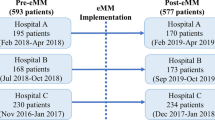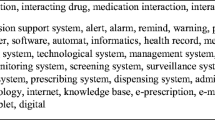Abstract
Introduction
Our aim was to study and possibly improve the clinical management of potential drug–drug interactions (pDDIs) in hospitalized patients by specific interventions.
Methods
During the initial period, inpatients on three medical wards were screened for major and moderate pDDIs using the interaction screening program Pharmavista. During the second period, patients at discharge were screened similarly. After assessment of the detected pDDIs for clinical relevance, written recommendations and/or information about the pDDIs were sent to the treating physicians. Feedback from the physicians and implementation of the recommendations were analyzed.
Results
During the initial period, 502 inpatients were exposed to 567 pDDIs, of which 419 (74%) were judged to be clinically relevant. Three hundred and forty-nine substantiated recommendations and 70 simple information leaflets were handed out to the physicians. Eighty percent (278 of 349) of the recommendations were accepted and implemented. During the second period, 792 patients at hospital discharge were exposed to 392 pDDIs, of which 258 (66%) were judged to be clinically relevant. Two hundred and forty-seven substantiated recommendations and 11 simple information leaflets were sent to the physicians. Seventy-three percent (180 of 247) of the recommendations were accepted. At hospital discharge, 47 of 71 interventions recommending checkable medication changes were implemented. One year after hospital discharge, 11 of 13 checked medication changes were still in place.
Conclusions
Clinically relevant pDDIs are common in patients on medical wards, and their management can be influenced by providing substantiated recommendations to physicians. Most changes in medication following such recommendations are still in place 1 year after discharge.

Similar content being viewed by others
Notes
Major interactions: May be life threatening, or permanent damage may be induced. Such drugs should not be administered together.
Moderate interactions: Frequently cause therapeutic difficulties and may even cause harm. Combinations may be administered, however, if patients are monitored carefully.
Minor interactions: Are associated with increased or reduced drug effects, but these alterations, in general, do not cause harm and can be tolerated.
Insignificant interactions: Cause mainly no or only unimportant effects, and no special action is required.
Unidentified source: For such interactions, no medical literature is available. Their clinical relevance is therefore unclear.
References
Einarson TR (1993) Drug-related hospital admissions. Ann Pharmacother 27(7–8):832–840
Bates DW, Cullen DJ, Laird N, Petersen LA, Small SD, Servi D, Laffel G, Sweitzer BJ, Shea BF, Hallisey R et al (1995) Incidence of adverse drug events and potential adverse drug events. Implications for prevention. ADE Prevention Study Group. JAMA 274(1):29–34
Classen DC, Pestotnik SL, Evans RS, Lloyd JF, Burke JP (1997) Adverse drug events in hospitalized patients. Excess length of stay, extra costs, and attributable mortality. JAMA 277(4):301–306
Lesar TS, Lomaestro BM, Pohl H (1997) Medication-prescribing errors in a teaching hospital. A 9-year experience. Arch Intern Med 157(14):1569–1576
Lazarou J, Pomeranz BH, Corey PN (1998) Incidence of adverse drug reactions in hospitalized patients: a meta-analysis of prospective studies. JAMA 279(15):1200–1205
Fattinger K, Roos M, Vergeres P, Holenstein C, Kind B, Masche U, Stocker DN, Braunschweig S, Kullak-Ublick GA, Galeazzi RL, Follath F, Gasser T, Meier PJ (2000) Epidemiology of drug exposure and adverse drug reactions in two swiss departments of internal medicine. Br J Clin Pharmacol 49(2):158–167
van den Bemt PM, Egberts TC, de Jong-van den Berg LT, Brouwers JR (2000) Drug-related problems in hospitalised patients. Drug Saf 22(4):321–333
Pirmohamed M, James S, Meakin S, Green C, Scott AK, Walley TJ, Farrar K, Park BK, Breckenridge AM (2004) Adverse drug reactions as cause of admission to hospital: prospective analysis of 18 820 patients. BMJ 329(7456):15–19
Mjorndal T, Boman MD, Hagg S, Backstrom M, Wiholm BE, Wahlin A, Dahlqvist R (2002) Adverse drug reactions as a cause for admissions to a department of internal medicine. Pharmacoepidemiol Drug Saf 11(1):65–72
Forster AJ, Murff HJ, Peterson JF, Gandhi TK, Bates DW (2005) Adverse drug events occurring following hospital discharge. J Gen Intern Med 20(4):317–323
Krahenbuhl-Melcher A, Schlienger R, Lampert M, Haschke M, Drewe J, Krahenbuhl S (2007) Drug-related problems in hospitals : a review of the recent literature. Drug Saf 30(5):379–407
van der Hooft CS, Sturkenboom MC, van Grootheest K, Kingma HJ, Stricker BH (2006) Adverse drug reaction-related hospitalisations: a nationwide study in The Netherlands. Drug Saf 29(2):161–168
Omar MA, Wilson JP (2002) FDA adverse event reports on statin-associated rhabdomyolysis. Ann Pharmacother 36(2):288–295
Jankel CA, Fitterman LK (1993) Epidemiology of drug–drug interactions as a cause of hospital admissions. Drug Saf 9(1):51–59
Smith L, McGowan L, Moss-Barclay C, Wheater J, Knass D, Chrystyn H (1997) An investigation of hospital generated pharmaceutical care when patients are discharged home from hospital. Br J Clin Pharmacol 44(2):163–165
Himmel W, Tabache M, Kochen MM (1996) What happens to long-term medication when general practice patients are referred to hospital? Eur J Clin Pharmacol 50(4):253–257
Cook RI, Render M, Woods DD (2000) Gaps in the continuity of care and progress on patient safety. BMJ 320(7237):791–794
e-mediat. Pharmavista - information for healthcare professionals. Version February 2005 ed: e-mediat AG, Schönbühl, Switzerland 2005
Vonbach P, Dubied A, Krahenbuhl S, Beer JH (2005) Evaluation of drug interaction screening programs. Forum Med Suisse 8S(Suppl 23):P15
Stockley IH (2002) Stockley’s drug interactions, 6th edn. The Pharmaceutical Press, London, Chicago
Hanlon JT, Weinberger M, Samsa GP, Schmader KE, Uttech KM, Lewis IK, Cowper PA, Landsman PB, Cohen HJ, Feussner JR (1996) A randomized, controlled trial of a clinical pharmacist intervention to improve inappropriate prescribing in elderly outpatients with polypharmacy. Am J Med 100(4):428–437
Leape LL, Cullen DJ, Clapp MD, Burdick E, Demonaco HJ, Erickson JI, Bates DW (1999) Pharmacist participation on physician rounds and adverse drug events in the intensive care unit. JAMA 282(3):267–270
Bond CA, Raehl CL, Franke T (2002) Clinical pharmacy services, hospital pharmacy staffing, and medication errors in United States hospitals. Pharmacotherapy 22(2):134–147
Dean B, Schachter M, Vincent C, Barber N (2002) Causes of prescribing errors in hospital inpatients: a prospective study. Lancet 359(9315):1373–1378
Wiltink EH (1998) Medication control in hospitals: a practical approach to the problem of drug–drug interactions. Pharm World Sci 20(4):173–177
Mannheimer B, Ulfvarson J, Eklof S, Bergqvist M, Andersen-Karlsson E, Pettersson H, von Bahr C (2006) Drug-related problems and pharmacotherapeutic advisory intervention at a medicine clinic. Eur J Clin Pharmacol 62(12):1075–1081
Chan AL (2005) Pharmacist intervention when interacting drugs are prescribed despite alerts. Am J Health Syst Pharm 62(17):1760–1763
Graham DJ, Staffa JA, Shatin D, Andrade SE, Schech SD, La Grenade L, Gurwitz JH, Chan KA, Goodman MJ, Platt R (2004) Incidence of hospitalized rhabdomyolysis in patients treated with lipid-lowering drugs. JAMA 292(21):2585–2590
Ratz Bravo AE, Tchambaz L, Krahenbuhl-Melcher A, Hess L, Schlienger RG, Krahenbuhl S (2005) Prevalence of potentially severe drug–drug interactions in ambulatory patients with dyslipidaemia receiving HMG-CoA reductase inhibitor therapy. Drug Saf 28(3):263–275
Kays MB, Overholser BR, Mueller BA, Moe SM, Sowinski KM (2003) Effects of sevelamer hydrochloride and calcium acetate on the oral bioavailability of ciprofloxacin. Am J Kidney Dis 42(6):1253–1259
Buurma H, De Smet PA, Egberts AC (2006) Clinical risk management in Dutch community pharmacies : the case of drug–drug interactions. Drug Saf 29(8):723–732
Kaushal R, Shojania KG, Bates DW (2003) Effects of computerized physician order entry and clinical decision support systems on medication safety: a systematic review. Arch Intern Med 163(12):1409–1416
Weingart SN, Toth M, Sands DZ, Aronson MD, Davis RB, Phillips RS (2003) Physicians’ decisions to override computerized drug alerts in primary care. Arch Intern Med 163(21):2625–2631
Payne TH, Nichol WP, Hoey P, Savarino J (2002) Characteristics and override rates of order checks in a practitioner order entry system. Proc AMIA Symp 602–606
Shah NR, Seger AC, Seger DL, Fiskio JM, Kuperman GJ, Blumenfeld B, Recklet EG, Bates DW, Gandhi TK (2006) Improving acceptance of computerized prescribing alerts in ambulatory care. J Am Med Inform Assoc 13(1):5–11
van Roon EN, Flikweert S, le Comte M, Langendijk PN, Kwee-Zuiderwijk WJ, Smits P, Brouwers JR (2005) Clinical relevance of drug–drug interactions : a structured assessment procedure. Drug Saf 28(12):1131–1139
Bergk V, Gasse C, Rothenbacher D, Loew M, Brenner H, Haefeli WE (2004) Drug interactions in primary care: impact of a new algorithm on risk determination. Clin Pharmacol Ther 76(1):85–96
Hansten PD, Horn JR, Hazlet TK (2001) ORCA: OpeRational ClassificAtion of drug interactions. J Am Pharm Assoc 41(2):161–165
Bobb A, Gleason K, Husch M, Feinglass J, Yarnold PR, Noskin GA (2004) The epidemiology of prescribing errors: the potential impact of computerized prescriber order entry. Arch Intern Med 164(7):785–792
Ray WA, Murray KT, Meredith S, Narasimhulu SS, Hall K, Stein CM (2004) Oral erythromycin and the risk of sudden death from cardiac causes. N Engl J Med 351(11):1089–1096
Juurlink DN, Mamdani M, Kopp A, Laupacis A, Redelmeier DA (2003) drug–drug interactions among elderly patients hospitalized for drug toxicity. Jama 289(13):1652–1658
Acknowledgements
We thank Sanofi Aventis, Meyrin/Switzerland, for financial support. The study was also supported by a grant from the Swiss National Science Foundation to SK (310000-112483/1). Furthermore, we thank e-Mediat, Schönbühl/Switzerland, for providing us the drug interaction screening program Pharmavista. The authors declare no conflict of interest directly relevant to the content of this manuscript.
Author information
Authors and Affiliations
Corresponding author
Rights and permissions
About this article
Cite this article
Vonbach, P., Dubied, A., Beer, J.H. et al. Recognition and management of potential drug–drug interactions in patients on internal medicine wards. Eur J Clin Pharmacol 63, 1075–1083 (2007). https://doi.org/10.1007/s00228-007-0359-4
Received:
Accepted:
Published:
Issue Date:
DOI: https://doi.org/10.1007/s00228-007-0359-4




